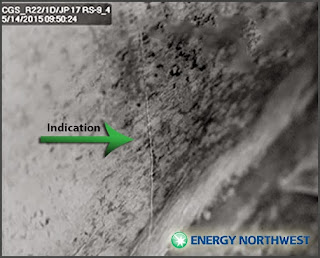 |
| Congratulating CGS on Breaker-To-Breaker run |
Recently, a contention was filed with the NRC, asking regulators to shut down Columbia Generating Station (CGS), which had just finished a 683 day breaker-to-breaker run. The basis of the contention was that an "indication" had been found during an inspection at CGS. Nuclear opponents claimed the plant should be shut down until the pipe was "fixed."
Yes, that is a typical nuclear opponent reaction to any event: "Shut it down!" A newspaper picked up the NRC contention story. Many nuclear opponents commented on the newspaper article.
Facts about the Indication
Energy Northwest has two blog posts that describe the indication, and discuss the newspaper article and the comments. In fact, the titles of the posts are explanatory:
The second post includes a lengthy quote from my comment on the newspaper article. I asked John Dobken of Energy Northwest, and he gave me permission to repost it here. (The Energy Northwest posts have excellent illustrations. I have transferred a few to this blog, but encourage you to read the original posts for a complete set of illustrations.)
----------
UPDATE: Too much news from too few facts (Pt. 2)
Posted on May 16, 2015
Much has been made in some circles this week about an indication (which could be a mark, a scratch, a welt, or even a crack) on one of 10 inlet risers in Columbia’s reactor pressure vessel.
The risers are 19-feet tall. The indication is a little over an inch long. The picture below shows a mock-up of the type of jet pump assembly Columbia uses. The arrow shows the location of the indication.
Inspectors first saw the indication during our 2011 refueling outage. We then looked at videotape back to 2001, where the indication was seen as well. There appeared to be no discernible change in the indication.
During the 2013 refueling outage, the riser was inspected again. The indication showed no discernible change.
This week, after a record-breaking 683-day continuous operation run in which Columbia generated 18-million megawatt hours of electricity, trained professionals again inspected the indication and found no change from the previous inspection.
In the comment section of a story on the subject in the Oregonian, Meredith Angwin (who blogs here) provided some much needed technical expertise to the discussion. Here’s what Meredith wrote:
I was a project manager at the Electric Power Research Institute in renewable and nuclear energy.
In all energy projects and many manufacturing environments, equipment is periodically inspected with “non-destructive evaluation.” If something shows up during the inspection, this is called an “indication.” An indication can be a crack…or it can be a minor flaw in the metal due to some other cause, such as a slightly thicker area from the manufacturing process.
After an indication is found, it is evaluated. If the evaluation shows no immediate danger of leak or rupture, the indication is re-evaluated at the next inspection. Many (probably most) indications are basically meaningless, in terms of the integrity of the metal. In this particular case, as Energy Northwest has stated, this indication hasn’t changed in more than a decade.
Because of the stringent safety requirements of the nuclear industry, indications must be reported to the NRC.
However, indications that just sit there for decades are not problems that are growing and dangerous.
Calling an indication a “crack” is jumping to conclusions. Cracks have to be dealt with. Indications have to be watched. After fourteen years without changes, though, I suspect that any corrosion engineer would say that this particular indication is probably just going to sit there forever without changing.
Energy Northwest will review this indication at every outage. All nuclear plants are required to keep watching indications, and Energy Northwest will do so.
Please read the analysis of the required certifications for anyone who evaluates the results of non-destructive evaluation. This is not a casual business, by any means.
Here’s a photo from the most recent inspection on Thursday. Additional review of the indication raised no concerns.
Energy Northwest will continue its monitoring and inspection program of the indication going forward.
(Posted by John Dobken)


2 comments:
Meredith, have you been following the reactor shutdowns in the Netherlands over cracks/flakes in the pressure vessels ( not to mention the kerfuffle about Areva's EPR pressure vessels )? John ONeill
Not following it directly, but Will Davis at Atomic Power Review is doing a great, well-referenced job. I follow him.
http://atomicpowerreview.blogspot.fr/2014/08/doel-3-and-tihange-2-units-back-in-news.html
Post a Comment